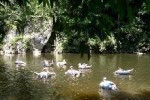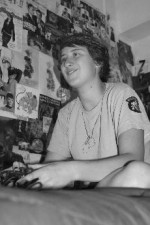Students explore Mayan culture in Belize

Imagine a course that combines ecology, history, and physics — and involves a trip to Belize during Spring Break. You don’t have to imagine, it’s being offered during the spring 2011 semester at Castleton. The Collapse of a Civilization: The Environment, History, and Science of the Maya, is a team-taught course instructed by professors Cynthia Moulton, Jonathan Spiro, and Catherine Garland. The course meets Tuesdays, and carries four World Views frame credits.
The course examines the Mayan Civilization in Central America. The students will then be asked to put their knowledge to use when they fly to Belize during spring break. While there, they will climb Mayan pyramids, canoe in the rivers of the jungle and interact with toucans. Students are expected to process what they have learned upon returning and interpret their findings in a way to understand contemporary issues affecting the sustainability of our planet, according to its course description.
Moulton is not a stranger to traveling for science. For several years, most recently in fall 2009, she traveled to St. John to explore the diversity of life in the tropics. Aubrey Goad, an art major, graduated in 2004 and went to St. John. There, she helped perform a reef check, “where we essentially collected data along the reefs in an effort to help preserve the endangered coral reefs, and the plant and animal life it sustains,” she said.
Catherine Garland traveled with the Civilization class to Belize in spring 2006 and again in 2008. She lit up as she spoke of her past experiences. Instead of the typical coastal experience, the class stays at a lodge inland, directly in the rainforest. While there, they have a Mayan tour guide, who is knowledgeable about the civilization’s culture. She described the activities the group participates in, including the canoe ride through the cave.
“The Mayans had the belief that if they die, they go into the underworld. These caves are seen as the entrance into the underworld,” she said.
She noted that the trip was a great way to get away from the noise of individual’s daily lives. They do not allow most technology, including IPods and computers. This creates a lot of time to enjoy the scenery. The class learns the constellations that the Mayans used as they star gaze at night. Also, their location is an oasis in itself.
“We stay right in the rainforest and can hear toucans and macaws, and we hear the howler monkeys at night,” she said.
Dakota Trufant, a mathematics major who has since graduated, participated in this course. He was overwhelmed while studying the culture of his own people.
“I had so much fun just being located in the jungle and learning about possible distant relatives experiences, lifestyles, and customs,” he said.
But not all the trip was as satisfying, he said.
“I remember Belize City being kind of a shithole, but that’s whatever,” he said.
Another student excited about the course is Phoebe Ezuruike, a junior health science major. This is her first time traveling with the college, and there are many things that are interesting her.
“I was glad when I heard a course about the Mayan Culture will be taught because I have heard a lot about the Mayan calendar and their insights in science. I know that the culture was really advanced beyond its time and its people were really interested in the future. I wonder what caused such a civilization to collapse. Was it due to someone’s greed and corruption?” she said.
Although the trip was open to all majors, there was an extensive application process and the cost of the trip is approximately $1,900, which includes everything. The professors asked a number of things from the applicants, including their program evaluation, as well as briefly describing their family and home community. They are also heavily interested in the students’ motivation for taking this course. Then, when it is narrowed down to the select 16-20 students, the professors meet with Dean Dennis Proulx, to make sure no one is on academic probation. The deadline for applications was Oct. 29.
There is no doubt that from students and teachers alike, the course and culminating trip is one of the greatest experiences of their lives, and they have memories that they will hold forever.
“One of my most favorite memories is splashing in the water at night and seeing the phosphorescent stuff in the water light up. It was like a dream…so magical. Lying on the beach under the stars, snorkeling in the ocean with the sea turtles and all the fish. It was like flying,” said Goad. “Although the water in Vermont isn’t as clear as in the Virgin Islands, I still keep my goggles and snorkel in the car all summer, just waiting for an opportunity to explore what’s hidden in the water.





